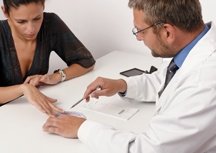To Your Health
March, 2007 (Vol. 01, Issue 03) |
|
|
Type A: These reactions are normal drug effects gone overboard, wherein the expected effects of a medication are exaggerated to the point of being undesirable or intolerable for patients.
Type B: These reactions are often bizarre and far more severe than any known side effects related to the drug prescribed, such as an anaphylactic reaction to penicillin. (Anaphylactic shock can lead to death in minutes if not treated appropriately.) If patients are not tested for what are called "antibody markers," type B reactions are completely unpredictable and may or may not depend on the dosage.
Harmful Drug Interactions
The scale of the drug interaction problem increases significantly in certain patient populations, especially among critical care patients; patients undergoing or recovering from surgical procedures; and among senior citizens, who are taking the greatest number of medications each day. One also must take the following into account:
- Some patients may see multiple physicians for acute and chronic conditions.
- Some patients may obtain medication from more than one pharmacy or by mail.
- An estimated 80 percent of elderly patients routinely take prescription and nonprescription medications concurrently.
 Your physician should do more than prescribe medication; he or she should inform you in full about the risks of taking any medication. But itís your health on the line, not your doctorís. Take responsibility for your own health by asking questions.
What's more, there are several types of reactions to watch out for.
Your physician should do more than prescribe medication; he or she should inform you in full about the risks of taking any medication. But itís your health on the line, not your doctorís. Take responsibility for your own health by asking questions.
What's more, there are several types of reactions to watch out for.
Drug-drug interactions: The altered performance of one drug by the administration of a different drug is considered a drug-drug interaction. The properties of either or both drugs can be severely enhanced or diminished, whereby the combination is less beneficial or even harmful when compared to either drug used alone.
Drug-food interactions: Most drug-food interactions are related to absorption of the drug (i.e., whether digestion aids or inhibits absorption of the medication). Hence, many prescription labels indicate "take with meal" or "take on empty stomach." However, your medication and your meal can interact in other undesirable ways.
One particularly significant reaction can occur when certain commonly prescribed antidepressants are taken concurrently with foods containing high levels of the compound tyramine. This can cause serious complications, including an acute increase in blood pressure. Some of the more common foods high in tyramine include avocados, bananas, cheese (especially aged), chocolate, coffee, processed meat (bologna, salami, summer sausage, etc.), raspberries, yogurt, tofu and wine (especially red).

